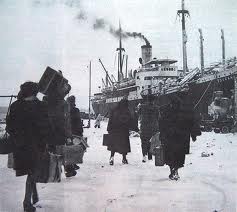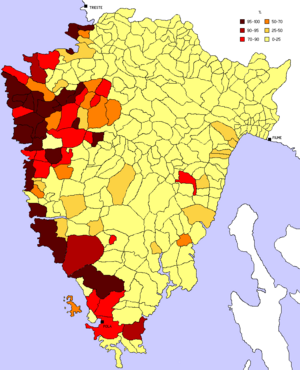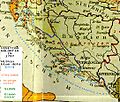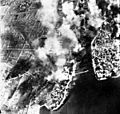Istrian-Dalmatian exodus facts for kids

The Istrian-Dalmatian exodus was a big movement of people after World War II. Many ethnic Italians left areas like Istria, Zadar, and Rijeka. These places were once part of Italy but became part of Yugoslavia after the war. Today, these areas are mostly in Croatia and Slovenia.
Around 230,000 to 350,000 people left these regions. Most were Italians, but some Croats and Slovenes also left. This movement started in 1943 and continued until 1960. Historians still discuss why so many people left. However, many Italians faced pressure to leave. This included violence in the early years. Later, it involved things like their property being taken by the government or unfair taxes. These actions made it very hard for them to stay.
Contents
Why People Left: The Exodus
Many people, mostly Italians, chose to leave the region. They faced economic problems and strong feelings of ethnic dislike. The world's political situation, which led to the Iron Curtain (a division between Eastern and Western Europe), also played a role.
In 1954, an agreement called the London Memorandum was signed. It gave ethnic Italians a choice: they could either leave or stay. Those who left were called optants. The Italian government promised to pay them for their lost property. After many people left, Yugoslav people moved into these areas.
When the Exodus Happened
The exodus took place over several years, from 1943 to 1960. Most Italians believe large numbers left during these specific years:
- 1943
- 1945
- 1947
- 1954
How Many People Left: Estimates
Historians have different ideas about how many people left:
- Vladimir Žerjavić (from Croatia) estimated about 191,421 Italian exiles from Croatian land.
- Nevenka Troha (from Slovenia) estimated about 40,000 Italian and 3,000 Slovene exiles from Slovenian land.
- Raoul Pupo (from Italy) estimated around 250,000 Italian exiles.
- Flaminio Rocchi (from Italy) estimated about 350,000 Italian exiles.
Paying for Lost Property
On February 18, 1983, Yugoslavia and Italy signed a treaty in Rome. Yugoslavia agreed to pay US$110 million to make up for the property taken from the exiles. This property was in a special area called Zone B of the Free Territory of Trieste. Before Yugoslavia broke up in 1991, it paid US$18 million. The issue of payments between Croatia and Italy is still not fully solved today.
See also
- Foibe massacres
- National Memorial Day of the Exiles and Foibe
- Free Territory of Trieste
- Italian Social Republic
- Ethnic cleansing
- Istria
- Dalmatia
- Dalmatian Italians
- Italian cultural and historic presence in Dalmatia
- Venice and Dalmatia
Images for kids
-
A painting showing the fall of the Republic of Venice (1797): the last Doge, Ludovico Manin, giving up his power.
-
An Austrian language map from 1896. Green areas show where Slavs were the majority. Orange areas show where Istrian Italians and Dalmatian Italians were the majority. The blue dots show the borders of Venetian Dalmatia in 1797.
-
The Bombing of Zadar in World War II by the Allies (1944). This event led to many Dalmatian Italians leaving the city.
-
The President of the Italian Republic Giorgio Napolitano speaking for the National Memorial Day of the Exiles and Foibe in 2007.
-
A concert at the Quirinal Palace with the President of the Italian Republic Sergio Mattarella for the National Memorial Day of the Exiles and Foibe in 2015.
See also
 In Spanish: %C3%89xodo istriano-d%C3%A1lmata para ni%C3%B1os
In Spanish: %C3%89xodo istriano-d%C3%A1lmata para ni%C3%B1os











